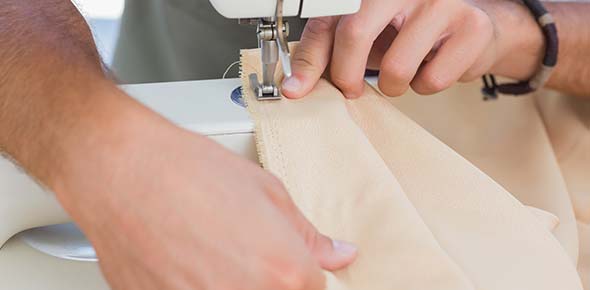What are the different types of screwdrivers normally used in an...
What will help you keep track of your tools?
You apply a light coat of oil when caring for pliers to
Why is cotton duck "canvas" primarily used in the construction of...
Which tester uses a 9V battery as a power source?
Which of the following is not an inspection item for a sewing machine?...
What is the first inspection requirement for all thermal radiation...
Which type of pliers should be used for cutting small, light materials...
Which of the following in not an ideal storage condition for textile...
When threading the tension and thread controller assemblies on the...
The stages of troubleshooting are to
Rigid upholstery foundations must provide
What type of wrench would be used when the correct size wrench or...
Which knot is used primarily to tie survival items and accessories to...
How do you hand shears to another person?
If a long measuring tape is allowed to sag, it
The parachute-packing paddle (fid) can be made out of any suitable,...
What thread runs parallel to the selvage edge and forms the framework...
At what temperature range does "Nomex®" material begin to char? ...
What will happen if shears are sharpened from the handle to the...
Which piece of safety equipment is used to limit damage from falling...
What should you use to dissolve grime that has built up on a sewing...
While sewing heavy material your needle starts bending and finally...
When fabricating a protective cover, which seam formation provides the...
To ensure a soundproofing panel will fit properly, you should
...
What can result if you do not use stencil paper in the stencil...
What component reduces needle thread friction on the Chandler® 767...
What is one rule to follow when using an adjustable wrench to remove a...
What is the advantage of the portable press?
The Consew® 206RB sewing machine motor with clutch has a maximum...
You can identify the Phillips screwdriver by its
When installing a needle into the needle bar, ensure the long groove...
What type of feed does the Consew® 206RB sewing machine...
Which type of light is allowed to show through the closed curtain...
Which tester incorporates the use of the A–14 regulator?
Protective covers used outdoors should be made
What type of material is used to repair soundproofing panels?
What type of stone should be used to sharpen shears?
Besides being of sufficient length and width to hold the complete...
What are the two basic types of weave patterns?
On what axis does the stitch forming mechanism rotate on the...
Approximately how many stitches per inch (SPI) are used in forming the...
Which seam characteristic is least important to its construction?
What component is used to engage the clutch with the motor?
What class of seam do you use when the bulk of the seam must be...
What fabric is used for protective covers and is versatile, durable,...
What can you do to ensure maximum benefits from the tools you use and...
What must you do to a jammed power tool?
An awl is used to
What is the maximum width of webbing?
When using a sewing machine and the seam knots are on the top ply of...
Which type of soundproofing is sewn with a diamond pattern to hold the...
The tensile strength of stored material may begin to be affected if...
When you are doing the final threading of the properly wound bobbin on...
Which direction is the eye of the needle threaded on the 206RB sewing...
When installing binding tape, how far from the selvage edge do you...
What is the minimum room temperature that must be maintained before...
One disadvantage of using Naugahyde® for upholstery is that it ...
What type of hand needle is best suited for installing hidden...
Which snap fastener installation press is to be used as a last resort?...
What type of hand needle has a rounded (blunt) point that moves and...
The Chandler® 767 sewing machine has what type of feed?
Which type of hand needle is most appropriate to use to repair and...
What are the uses of protective covers?
Which upholstery component gives an item shape and enhances the...
The purpose of installing a finger guard on a sewing machine is...
What is the maximum lift of the alternating presser feet on the...
What seam is used as the first step for other seam formations?
What knot is defined as the simplest method of joining two threads or...
What component on the Consew® 206RB sewing machine re-engages the...
What component is used to engage the reverse mechanism on the...
What stitching do you use at the skirt of a parachute canopy?
Which methods of installation are used to install thermal radiation...
What stitch pattern always begins and ends with a bar tacking?
When inspecting a protective cover, you should check for all of the...
The tensile strength of the fabric.
Which type of hand needle should be used to sew fabrics with a loose...
What type of material are thermal radiation barrier curtains made out...
When using a pneumatically powered impulse sealer to fabricate batt...
What are the two types of woodworking chisels?
Which tape is used to cover machine-sewn seams on thermal radiation...
In the seam specification 301–SSa–1, 301 indicates...
What twist of thread is used on sewing machines?
To increase tension on the needle thread you turn the
What does the number 2 in SSa–2 indicate?
What two wrenches have been combined to make up a combination wrench? ...
What is the standard amount of turn under when installing a patch to a...
During repair of the rubberized backing of thermal radiation barrier...
















